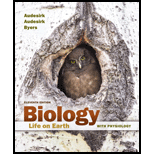
Concept explainers
Which of the following is True for one glucose molecule?
- a. Fermentation produces 2 ATP.
- b. Glycolysis followed by fermentation nets 4 ATP.
- c. Ethanol is one end product of glycolysis.
- d. The overall equation for photosynthesis is the reverse of that for aerobic glucose breakdown.
Introduction:
Glucose metabolism is a cycle of biological processes which can break down glucose molecules to obtain ATPs. Glycolysis is a part of glucose metabolism that forms four ATPs among which two are re-used and thus yields a net gain of two ATP molecules. Photosynthesis is a process in which chloroplasts capture light energy from sun and converts into chemical energy of food.
Answer to Problem 1MC
Correct answer:
The overall equation for photosynthesis is the reverse of that for aerobic glucose breakdown is true for glucose molecule. Therefore, option (d) is correct.
Option (d) is given as “The overall equation for photosynthesis is the reverse of that for aerobic glucose breakdown”.
Explanation of Solution
Justify reason for the correct statement:
In photosynthesis, chloroplasts capture light energy from the sun and convert it into chemical energy. This energy is further used as food or stored as sugar in the plant in this process, the formation of glucose molecule and oxygen takes place in the presence of light. Chemical equation of photosynthesis best describes that complete glucose breakdown is a reverse of glucose formation in photosynthesis.
Hence, option (d) is correct.
Justify reasons for incorrect statements:
Option (a) is given as “Fermentation produces 2 ATP”.
Fermentation produces 2 ATP molecules in anaerobic condition. During fermentation, pyruvate is converted into lactate or ethanol and carbon dioxide. Hence it is a wrong answer.
Option (b) is given as “Glycolysis followed by fermentation nets 4 ATP”.
Glycolysis produces 4 ATPs from that two are re-used and yields a net gain of two ATP molecules. Hence it is a wrong answer.
Option (c) is given as “Ethanol is one end product of glycolysis”.
Ethanol is one end product of fermentation not of the glycolysis. The end product of glycolysis is pyruvate. Hence it is a wrong answer.
Hence, options (a), (b), and (c) are incorrect.
During photosynthesis, chemical energy is stored as the glucose molecules, while during glucose breakdown that energy is released to generate ATP.
Want to see more full solutions like this?
Chapter 8 Solutions
Biology: Life on Earth with Physiology (11th Edition)
- 12. Calculate the area of a circle which has a radius of 1200 μm. Give your answer in mm² in scientific notation with the correct number of significant figures.arrow_forwardDescribe the image quality of the B.megaterium at 1000X before adding oil? What does adding oil do to the quality of the image?arrow_forwardWhich of the follwowing cells from this lab do you expect to have a nucleus and why or why not? Ceratium, Bacillus megaterium and Cheek epithelial cells?arrow_forward
- 14. If you determine there to be debris on your ocular lens, explain what is the best way to clean it off without damaging the lens?arrow_forward11. Write a simple formula for converting mm to μm when the number of mm's is known. Use the variable X to represent the number of mm's in your formula.arrow_forward13. When a smear containing cells is dried, the cells shrink due to the loss of water. What technique could you use to visualize and measure living cells without heat-fixing them? Hint: you did this technique in part I.arrow_forward
- 10. Write a simple formula for converting μm to mm when the number of μm's are known. Use the variable X to represent the number of um's in your formula.arrow_forward8. How many μm² is in one cm²; express the result in scientific notation. Show your calculations. 1 cm = 10 mm; 1 mm = 1000 μmarrow_forwardFind the dental formula and enter it in the following format: I3/3 C1/1 P4/4 M2/3 = 42 (this is not the correct number, just the correct format) Please be aware: the upper jaw is intact (all teeth are present). The bottom jaw/mandible is not intact. The front teeth should include 6 total rectangular teeth (3 on each side) and 2 total large triangular teeth (1 on each side).arrow_forward
- Answer iarrow_forwardAnswerarrow_forwardcalculate the questions showing the solution including variables,unit and equations all the questiosn below using the data a) B1, b) B2, c) hybrid rate constant (1) d) hybrid rate constant (2) e) t1/2,dist f) t1/2,elim g) k10 h) k12 i) k21 j) initial concentration (C0) k) central compartment volume (V1) l) steady-state volume (Vss) m) clearance (CL) AUC (0→10 min) using trapezoidal rule n) AUC (20→30 min) using trapezoidal rule o) AUCtail (AUC360→∞) p) total AUC (using short cut method) q) volume from AUC (VAUC)arrow_forward
 Concepts of BiologyBiologyISBN:9781938168116Author:Samantha Fowler, Rebecca Roush, James WisePublisher:OpenStax College
Concepts of BiologyBiologyISBN:9781938168116Author:Samantha Fowler, Rebecca Roush, James WisePublisher:OpenStax College
 Biology (MindTap Course List)BiologyISBN:9781337392938Author:Eldra Solomon, Charles Martin, Diana W. Martin, Linda R. BergPublisher:Cengage Learning
Biology (MindTap Course List)BiologyISBN:9781337392938Author:Eldra Solomon, Charles Martin, Diana W. Martin, Linda R. BergPublisher:Cengage Learning Biology: The Dynamic Science (MindTap Course List)BiologyISBN:9781305389892Author:Peter J. Russell, Paul E. Hertz, Beverly McMillanPublisher:Cengage Learning
Biology: The Dynamic Science (MindTap Course List)BiologyISBN:9781305389892Author:Peter J. Russell, Paul E. Hertz, Beverly McMillanPublisher:Cengage Learning Biology: The Unity and Diversity of Life (MindTap...BiologyISBN:9781337408332Author:Cecie Starr, Ralph Taggart, Christine Evers, Lisa StarrPublisher:Cengage Learning
Biology: The Unity and Diversity of Life (MindTap...BiologyISBN:9781337408332Author:Cecie Starr, Ralph Taggart, Christine Evers, Lisa StarrPublisher:Cengage Learning BiochemistryBiochemistryISBN:9781305577206Author:Reginald H. Garrett, Charles M. GrishamPublisher:Cengage Learning
BiochemistryBiochemistryISBN:9781305577206Author:Reginald H. Garrett, Charles M. GrishamPublisher:Cengage Learning





